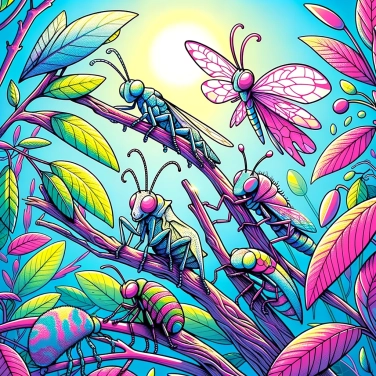Mimicry allows certain insects to camouflage themselves by imitating the appearance of a specific environment or organism, making them less visible to predators. This camouflage mechanism provides them with better protection and increases their chances of survival.

Mimicry in insects is when these little creatures take on the astonishing appearance of other beings or their environment to avoid being eaten. It all comes down to natural selection: insects that accidentally developed a look similar to a leaf, a twig, or a dangerous creature were less likely to be spotted by predators and therefore survived more easily. Naturally, these disguise experts pass their genes to their offspring, strengthening these mimetic traits generation after generation. This clever disguise can take many forms: imitation of color, silhouette, behavior, or even a specific scent. And the funniest part is that the predators, deceived, actively help improve this camouflage skill by eliminating poorly disguised or easily spotted insects.
Mimicry and camouflage are cousins, but they do not play exactly the same role. Camouflage mainly consists of blending in with one’s environment: the insect takes on the appearance of a leaf, a branch, or a rock to escape the gaze of predators. Mimicry, on the other hand, goes further: it is the precise imitation of a different species, often toxic or dangerous, to deceive its enemies. Essentially, camouflage makes you invisible, while mimicry makes you visible, but as something that predators prefer to avoid. Some insects even combine both approaches, alternating between stealth and intimidation depending on the situation.
The choice of mimetic models does not depend on a conscious decision by the insect, but on a gradual selection favored by evolution. Basically, insects that naturally resemble their environment or other dangerous species survive better, are less likely to be eaten, and have more descendants. Over time, these descendants will retain and improve these useful resemblances. Insects that mimic inert objects (branches, leaves) benefit from the fact that predators notice them much less. Those imitating toxic species play on the visual memory of predators, who associate them with danger and avoid them. There's no chance involved here, just a story of natural selection: those who imitate the right models fare better than others.
The Birch Moth is a classic example of a mimetic insect: resting on a tree trunk, its speckled wings perfectly mimic the bark, making it almost invisible to predators. Another remarkable specialist is the Orchid Mantis, with its pink and white flower-shaped body, which remains motionless among the orchids, ensnaring both its prey and potential predators. The Walker Caterpillar, with its long and slender body, camouflages itself by remaining still like a twig or a branch. Even more impressive, some stick insects, like the Stick Insect, resemble dry branches so closely that you really have to look twice to spot them. Finally, the Membracid develops strange structures that imitate thorns or plant thicknesses to avoid being prematurely eaten. All these insects use camouflage based on the precise imitation of their environment or other organisms.
Mimicry allows insects to avoid predators by going completely under their radar. Those who succeed in their imitation increase their chances of survival, grow quietly, and reproduce effectively. Thanks to natural selection, advantageous mimetic traits are preserved from generation to generation. As a result, species become highly specialized, some to the point of resembling their original model like two peas in a pod. In contrast, those unable to master this art of camouflage are often quickly eliminated by their predators. Thus, mimicry acts as a powerful engine of evolution, directly influencing the diversity and adaptation of insects to their environment.
The giant stick insect can sometimes measure over 30 centimeters, and its plant-like appearance is so convincing that even specialists can confuse it with a real branch or a dead leaf.
Mimicry can also be auditory. For example, certain species of nocturnal butterflies disrupt the echolocation of bats by imitating the ultrasonic sounds produced by them.
Some innocent flies use mimicry by resembling threatening bees or wasps in order to avoid potential predators that would fear being stung.
Mimicry can also work in reverse: some predators, like the orchid mantis, perfectly adopt the appearance of an orchid flower to attract their prey and capture them without raising suspicion.
Predators can be deceived by mimicry, avoiding insects that resemble toxic or dangerous species. However, some predators can learn and develop strategies to identify and capture these insects despite their deceptive appearance.
Camouflage involves blending into the environment by mimicking its color, shape, or texture to become invisible to predators. Mimicry, on the other hand, entails imitating a specific species or element of the environment (leaves, twigs, toxic insects, etc.) to deceive predators and enhance one’s chances of survival.
No, although the most common use of mimicry is indeed defensive, some insects also use aggressive mimicry to hunt or attract their prey. For example, some praying mantises imitate flowers to easily attract and capture their victims.
Complex environments, rich in biodiversity and featuring varied ecological interactions, such as tropical forests, particularly promote the emergence and maintenance of mimicry in insects due to the strong selective pressures exerted by predators.
Mimicry is an evolutionary trait that generally develops over very long periods through natural selection. As the most well-camouflaged or model-resembling insects preferentially survive, mimetic traits become predominant in the population over generations.

0% of respondents passed this quiz completely!
Question 1/5